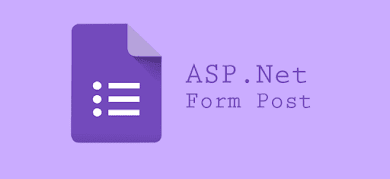HTTP GET and
HTTP Post is the most common method used by HTTP.
- HTTP Get the return response from the server to client.
- HTTP Post send data client (Browser to the server) .
ASP.Net MVC C# has a built-in model attached view for form data submission and validation, which is good but not good as for users who are using simple posts form the method. So I will show you different ways to send data to the server using form method post like PHP.
Demo Table Name (Student)
|
SN |
Field |
Data Type |
|
1 |
Roll |
Int |
|
2 |
Name |
Varchar(50) |
|
3 |
City |
Varchar(50) |
Store Procedure
create Proc[dbo].[AddStudent]
(
@roll int,@name varchar(50),city varchar(50)
)
AS
BEGIN
insert into student values(@roll,@name,@city)
end
HTML Form
<form method="post">
Roll : <input type="text" name="Roll" required /><br />
Name : <input type="text" name="Name" required /><br />
City : <input type="text" name="City" required /><br />
<input type="submit" name="submit" value="Save" />
</form>
Model
public class Student
{
public string Roll { get; set; }
public string Name { get; set; }
public string City { get; set; }
}
Method 1 (Model attached View)
I hate this method because it is complicated to make a form using razor@model ProbuzzMediaWebsite.Models.UserModel
<script src="~/Scripts/jquery-1.10.2.min.js"></script>
<script src="~/Scripts/jquery.validate.min.js"></script>
<script src="~/Scripts/jquery.validate.unobtrusive.js"></script>
@using (Html.BeginForm())
{
@Html.AntiForgeryToken()
@using (Html.BeginForm())
{
@Html.AntiForgeryToken()
@Html.ValidationSummary(true)
@Html.LabelFor(model => model.Roll, new { @class = "control-label"
})
@Html.EditorFor(model => model.Roll) <br />
@Html.ValidationMessageFor(model => model.Roll, "", new { @class = "text-danger" })
@Html.LabelFor(model => model.Name, new { @class = "control-label"
})
@Html.EditorFor(model => model.Name) <br />
@Html.ValidationMessageFor(model => model.Name, "", new { @class = "text-danger" })
@Html.LabelFor(model => model.City, new { @class = "control-label"
})
@Html.EditorFor(model => model.City) <br />
@Html.ValidationMessageFor(model => model.City, "", new { @class = "text-danger" })
<input type="submit" value="Create" class="btn btn-default" />
}
Controller
[HttpPost]
[ValidateAntiForgeryToken]
public ActionResult StuAdd(FormCollection data)
{
string ErrMsg = "";
UserModel ob = new UserModel();
AdminRepository cob = new AdminRepository();
Boolean flag = true;
if (ModelState.IsValid)
{
ob.Roll = data["Roll"];
ob.Name = data["Name"];
ob.City = data["City"];
flag = cob.SaveEmployee(ob, ref ErrMsg);
if(ErrMsg=="")
return RedirectToAction("EmployeeIndex","CRMAdmin");
else
return RedirectToAction("Error","Common", new { msg = @ErrMsg});
}
return RedirectToAction("/Common/Error");
}
Method 2
[HttpPost]
public ActionResult StuAdd(StudentModel data)
{
string ErrMsg = "";
CommonRepository ob = new CommonRepository();
if(ob.SavePostReport(data,ref ErrMsg))
return RedirectToAction("ClientPost","Operator");
else
return RedirectToAction("Error", "Common", new {msg=ErrMsg });
}
Note :
This is the best method to pass data to form post because PHP uses the same approach. Make sure that your model member name and HTML form control name must be matched.Repository
public bool SaveStudent(StudentModel ob, ref string ErrMsg)
{
String result = "";
try
{
using (SqlConnection dbcon = new SqlConnection(ConfigurationManager.ConnectionStrings["dbConnection"].ToString()))
{
using (SqlCommand cmd = new SqlCommand("[dbo].[AddStudent]", dbcon))
{
cmd.CommandType = CommandType.StoredProcedure;
cmd.Parameters.AddWithValue("@roll", Convert.ToInt16(ob.Roll));
cmd.Parameters.AddWithValue("@name", ob.Name);
cmd.Parameters.AddWithValue("@city", ob.City);
if (dbcon.State == ConnectionState.Closed)
dbcon.Open();
cmd.ExecuteNonQuery();
result = "1";
}
}
}
catch (Exception ex)
{
ErrMsg = ex.Message;
}
if (result == "1")
return true;
else
return false;
}



No comments:
Post a Comment